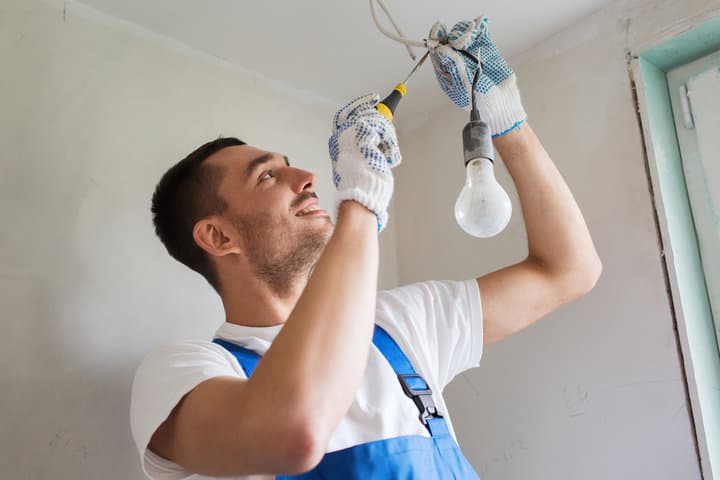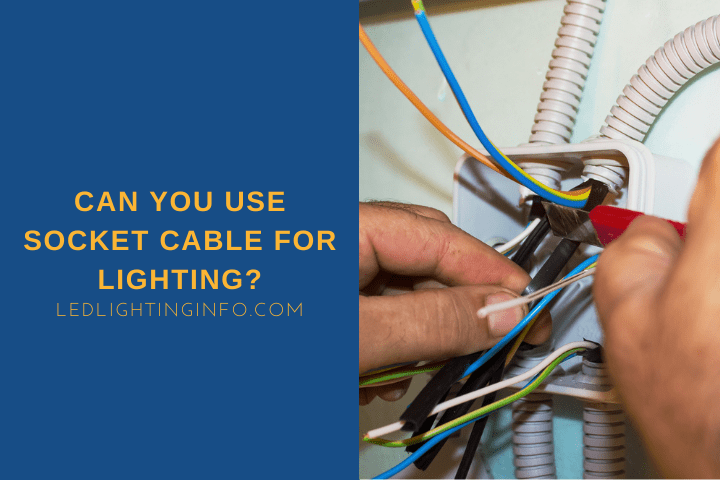Whether you’re planning on adding some new lights to your home or rewiring an entire room, you’ll want to consider the cable you’re using.
Not all wires are the same – and if you use the wrong wiring for the wrong job, you could end up causing all kinds of headaches.
That could include devices not working properly or even putting your home at risk if you mix up wires and connect a device to an unsuitable circuit breaker.
So, say you have some socket cable to hand – can you use that for lighting fixtures?
Using socket cable for lighting doesn’t usually cause problems because socket wire is a thicker gauge, rated for higher amps and therefore more watts than a normal lighting circuit. It won’t be overloaded. However, it will be thicker and harder to work with, especially behind switches.
To look at this in more detail, I’ll explain:
- The type of cable used in standard sockets
- The type of cable you need for lighting
- Whether lights can be safely connected with socket cable
What Type Of Cable Is Used For Standard Sockets?

Before we look at the type of cable used for sockets, let’s quickly go through how the cable is graded.
The wires used for all kinds of electrical applications are measured in thickness using the American Wire Gauge (AWG) system.
Most wires used in the home are either 12/2 or 14/2, with a lower number meaning a thicker wire.
12/2 wire measures 0.08 inches in diameter (2.05mm), while 14/2 wire measures 0.06 inches in diameter (1.63mm).
The /2 refers to the number of cables inside a wire – normally a hot and a neutral – though it may also contain a bare ground wire, so it has 3 cables inside.
You can get 12/3 or 14/3 wire, but that’s not usually common in US homes – it’d be used where circuits have a higher amperage and require a double circuit breaker.
Now the important thing to note here is the thickness of the wire, as that relates to the resistance of the circuit.
Wires that are thicker (remember – with a lower number for their AWG) have less resistance and so are rated for higher amperage circuits.
How many exactly?
Well, the ones you need to know about for now are that 14-gauge wire is rated for 15 amp circuits, and 12-gauge wire is rated for 20 amp circuits.
American homes can have either 15 amp or 20 amp circuits for their sockets, but they all generally use 12-gauge wire as standard.
There’s no safety concerns with using a thicker wire than the circuit needs, so for simplicity’s sake all sockets are generally wired in with the same 12-gauge wire.
What Cable Size Is Required For Lighting?

Lighting circuits in the home are generally different and will normally be on a 15 amp circuit.
Lights don’t require the same wattage as the devices you’ll be plugging into the sockets in your home, so using a lower amperage circuit is just a safer choice.
With that in mind, most lighting circuits will use 14-gauge wire.
Why not use 12-gauge wire everywhere if there are no real risks in doing so?
It’s more of a practical decision because the thickness of a wire impacts how easy it is to work with.
Sockets are generally quite simple when it comes to wiring, but with lighting, things can get a little more complicated.
You might have dimmer switches or motion sensors, which can then be split between lighting fixtures.
This means that you might be dealing with several connectors behind a light switch or dimmer.
You’ll notice how harder it is to work with everything if the wire is less pliable because you’ve used something thicker than needed.
So in most lighting circuits, 14-gauge wire is generally used.
It’s worth noting that this is specific for indoor lighting.
If you’re planning landscape lights, you may need to use a thicker wire gauge because of voltage drop.
Voltage drop isn’t really an issue with indoor lights because they aren’t low voltage, which is where losing a percentage of voltage has a more profound impact.
Also, the circuits are normally shorter than outdoor ones.
Can Lighting Be Safely Connected With Socket Cable?

We’ve established what cables are needed for sockets and lighting, but also that there are no risks involved in using a thicker wire than necessary for the job – just some inconvenience regarding how easy the wire is to work with.
So simply, lighting can be safely connected with a socket cable if you want to.
When you want to wire up sockets with lighting cable, you’re more likely to have issues since you could overload the wires.
It’s why you should avoid wiring a socket onto a lighting circuit in general.
Also, if you’re planning on extending an existing lighting circuit but only have 12-gauge wire, and the existing circuit uses 14-gauge wire, know that it will be acceptable to splice in the thicker cable.
There are no real downsides to this either.
Again, as long as you’re always using the minimum thickness for the amperage of the circuit, then you can mix and match wire gauges.
So adding a length of 12-gauge wire to a 14-gauge circuit running 15 amps is fine.
Adding a length of 14-gauge wire to a 12-gauge circuit running 20 amps is not.
Final Words
Socket cable is thicker than lighting cable, which allows it to be used in higher amperage circuits, but using thicker wire than you need for a circuit doesn’t really cause safety risks.
So yes, if you have some socket wire available and want to use it for lighting, go ahead.
But for new installations where you’ll need to purchase wire, you may as well stick to the standard 14-gauge wire for lighting circuits since it’s all you need and easier to work with.
Have you ever had issues with the wire being too thick and difficult to work with?
Or have you tried to wire a socket onto a lighting circuit may be, and had some issues?
Looking for an LED bulb but not sure what type you need?
Check out my free bulb picker and select the right bulb within few clicks.

